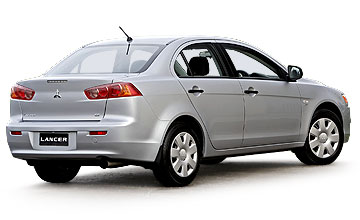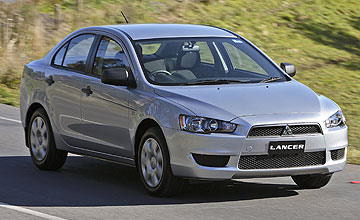Mitsubishi / Lancer / ES sedan

Our opinion
 We like
We like
Styling, safety, practicality, eager handling, sporty engine performance, great fuel economy, value, long warranty
 Room for improvement
Room for improvement
Lots of road noise, low-speed dynamic finesse falters at speed, firm ride

SOME car-makers would kill to have the Mitsubishi Lancer’s slightly renegade reputation.
Always a little rough around the edges, this most masculine of small-cars has been a proven rally champion since its 1974 Aussie inception, and maintained a somewhat roguish appeal through its turbo-charged 4WD Evolution incarnations in the 1990s and today, despite the pseudo Celica Lancer Liftback series of 1977 to 1981.
Indeed, speak to any kid raised on a Playstation Gran Turismo and they’ll tell you that the Lancer has the street cred to cut it.
Like somebody’s cocky kid brother, the Lancer has long lacked the final polish and social graces to win road test comparisons. Raffish against a Corolla, uncouth compared to a Mazda3, even the rather dowdy previous-generation CG/CH series drove to its own beat.
So has any of this boyish charm changed with the CJ series released late last year?
Well, stylistically speaking, the pudginess of the previous model has given way to a handsome four-door sedan with a very Alfa 156 profile, an aristocratic nose (to more gently snuff out wayward pedestrians), rising feature line in profile and wide track wheelarches that improve the Lancer’s road stance out of sight.
And Italy-meets-Magna is the only way you’d describe the distinctly Japanese matching front and rear-end graphics.
For the record, the car’s shadow is 35mm longer and 65mm wider than before, with the wheelbase and front and rear track having also grown accordingly.
The interior is instantly familiar to anybody who has sat in a current model Outlander SUV. Both share the same platform, with the Lancer also adopting much of its cabin architecture.
(In fact, the CJ Lancer series shares its platform with the Outlander compact SUV, as well as the Dodge Caliber hatch and Avenger sedan, Chrysler Sebring, Jeep Patroit and Jeep Compass compact SUVs.)
Hmm... lots of (albeit well-made) hard black plastics surfaces, relieved by a concerted effort in symmetry, minimalism and metallic-style horizontal trim spearing from door to door across the appealingly modern facia.
In fact the whole dashboard works well, with easy reach of the audio controls in the upper half of the console (flanked by a pair of effective ventilation outlets) and a most generic set of heater, ventilation and air-conditioning controls below. It all looks classy lit up at night too.
Very Alfa-esque too is the cowled instrumentation binnacle, housing a nicely designed speedometer on the left and a 6500rpm-redlined tachometer to the right, with an electronic display for temperature, fuel, trip and odometer-related information. It’s even illuminated in the same red as you’d find in a 147 or 156. Very smart indeed.
What isn’t so clever is the upper console digital display that is all but impossible to read in direct sunlight or when the headlights are turned on during the day. You can’t increase the illumination either.
However, a decent sized glovebox, lots of slots for bits and pieces, large exterior mirrors and a comfortable driving position shows that Mitsubishi hasn’t taken its eye off the important aspects of interior design and layout.
Four overhead grab-handles, a very Euro-style lane-change indicator function and a nicely integrated audio set-up further enhance the Lancer inside.
The front seats are broad if a little flat in support (offering no lumber adjustment is an oversight), but the driver’s is height adjustable, the good looking T-spoke steering wheel of perfect size tilts, and there is just about enough space up front for even the tallest folk.
In the back, there is also agreeable room for two adults and a small kid, backed up by lots of leg space, a decent amount of shoulder and headroom, and head restraints and a lap/sash seatbelt for all three.
Mitsubishi says that there is more space overall inside the CJ Lancer than there is in the 1985 to 1991 first-generation TM-TP Magna sedan.
The 400-litre capacity boot is backed up by a split-fold rear seat that makes the most of the cargo space this car offers, although the rear backrests only fall onto the cushion, resulting in a non-flat load area into the cabin. The aperture into the boot is quite small too.
On the road, the eager yet extremely economical 2.0-litre four-cylinder petrol engine proves that Mitsubishi has learnt much from its years in competition.
Rorty, revvy and punchy, with a wide spread of torque to draw upon, it endows the Lancer with almost hot-hatch vigour when coupled with a slick and easy short-throw five-speed manual gearbox and well-measured light clutch that make light work of rowing the Lancer along.
The Mitsubishi’s real world acceleration feels faster than the official figures suggest – the manual ES sprints to 100km/h in 9.5 seconds on the way to a 200km/h top speed – particularly once on the move.
Surprisingly quick and communicative steering and a flat attitude to cornering further cement the Lancer’s driver-orientated attitude, aided by plenty of grip from the front wheels, a rear-end that likes to stick to the road, and a general poise and balance that urges keener drivers to push on harder.
However, as speeds build, the Lancer begins to lose composure, and can become a little ragged through quicker corners.
The driver needs to be attentive with constant steering corrections in order to maintain fluid progress, while the steering does not quite impart the same sort of confidence promised at lower velocities. And while grip isn’t lost easily at all, a nice clean cornering line can be.
Perhaps the Yokohama Advan 206/60R16 tyres are letting the side down a bit, but the Lancer loses any air of sophistication that its complex multi-link rear suspension specification might suggest.
Plus, the ride, while firm and absorbent, isn’t as supple as the comfiest small cars (Ford Focus, VW Golf, Nissan Tiida and Mazda3), lacking their ability to smother most road imperfections.
And there is far too much road noise coming into the cabin. Perhaps the Mazda 3 inspired the Lancer a tad too much in this regard. On the other hand, the sporty signature-Lancer exhaust note can be quite appealing to some.
In our estimation, the Mitsubishi stands with the Mazda and Focus as the most desirable small sedans available at the price.
Along with dual front airbags, the company should be congratulated for fitting ESC stability and traction control and a knee area airbag as standard equipment, and offers the added safety of side and curtain airbags for a miniscule $800 extra.
With even the base model ES (tested here) also including cruise control, air-conditioning, power windows, electric mirrors, CD/MP3 compatible audio and a comprehensive trip computer display, the Lancer cements its position among the top three small-cars for value as well.
Right now, we can’t think of a better-looking sedan in that class either.
Still a tad rambunctious, Mitsubishi’s once-adolescent Lancer is now a more sophisticated but never boring and still extremely likable young larrikin.

No comments:
Post a Comment